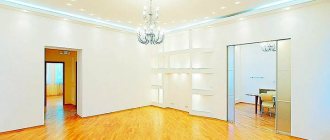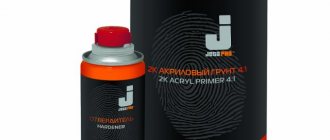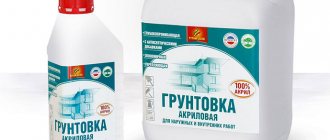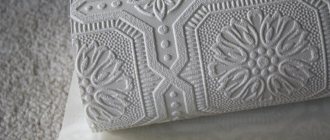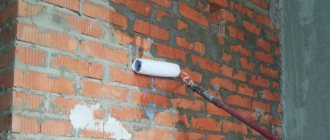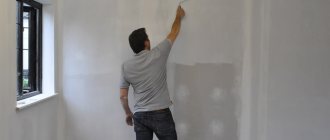| № | Name | Rating | Nomination |
| 1 | GLIMS PrimeGround | 4.88 | Optimal ratio of price and quality of coating |
| 2 | KNAUF Tiefengrund | 4.85 | Universal composition for interior and exterior work |
| 3 | Ceresit CT 17 | 4.65 | The most popular |
| 4 | Axton | 4.60 | Low price |
| 5 | VGT | 4.57 | Largest volume |
| 6 | Intercolor | 4.56 | Best drying time |
| 7 | Tikkurila Euro Primer | 4.55 | Suitable for processing fibreboards |
| 8 | TEX Pro | 4.50 | Affordable concentrated primer |
| 9 | Formula Q8 (Prestige) | 4.50 | High resistance to freezing |
| 10 | Prospectors | 4.10 | A reliable product for removing dust and strengthening walls |
Popular manufacturers
The most popular liquid compositions for preparing walls for finishing are produced by the brands GLIMS, KNAUF and Ceresit. Primers from these manufacturers are considered the most effective.
Products from GLIMS
They dry quite quickly, are perfectly absorbed and protect the coating from mold formation. In addition, building materials from this brand are sold at a very affordable price.
KNAUF
produces more expensive primer with a wide range of applications. True, German quality has recently begun to fail: counterfeits are becoming more and more common. But even despite this, even experienced builders continue to use building materials from KNAUF. The main thing is to know where to buy.
Ceresit
considered one of the most popular brands. The manufacturer produces high-quality primers for a variety of tasks. The quality of mixtures and building materials produced under this brand remains unchanged. But, having decided to buy primer from Ceresit, you need to decide what you need it for. Not all compositions can be applied under light wallpaper and used for painting.
The need to use primers
Wall primer for wallpaper is available in bulk or liquid form. It is pre-applied before finishing. It is necessary to prime the surface for a number of reasons:
- the ability to create a monochromatic coating;
- isolation of dust particles under a layer of composition;
- the ability to envelop pores - the primer allows you to get a perfectly smooth wall, without cracks or chips;
- increasing the reliability of the setting of the finish;
- ensuring the quality of fixation and adhesion of wallpaper;
- increasing the resistance of materials to wear, moisture and fungal environments;
- saving on glue - it lays down in an even layer, since the wall becomes less porous.
Advice! If there is mold on the wall, then after applying primer with antibacterial properties it will disappear.
How to choose a primer
Building materials of this type differ in purpose and form of release: dry, liquid and concentrated. It is better to select a product according to your needs and the base material that needs to be treated.
For weak grounds
The best option would be a deep penetration strengthening primer. It will not only remove dust, but also protect the surface from further destruction. It is especially important to apply such a primer before pasting walls with heavy multi-layer wallpaper.
For rooms with high humidity levels
formulations containing antiseptic and antifungal components are more suitable. Such products prevent the appearance of mold under the finish coating.
Walls that do not have serious defects
It is recommended to treat with the simplest liquid primers. They are more affordable than products with an antifungal/antiseptic composition, have virtually no odor, and dry much faster. Their only task is to strengthen the adhesion of glue and wallpaper to the base.
In any residential premises it is better to use water-based acrylic primers. Such products do not contain organic solvents and are completely safe.
The need to use soil
Applying impregnating agents to wall surfaces
First, let's decide whether the walls need to be treated with impregnating agents before wallpapering. Often, seemingly high-quality wallpaper over time begins to move away from the surface of the walls.
A more undesirable scenario is the appearance of mold under a layer of glued paper. In both cases, restoration will be required. Meanwhile, everything could have been much simpler if the primer had been purchased in a timely manner.
Regardless of what composition is used, be it a primer for non-woven wallpaper or an impregnation for gluing paper, similar goals are pursued:
- ensuring the density and strength of the finished surface;
- ensuring maximum adhesion of the substrate and base;
- ensuring the stability of walls against biological factors, including fungal infections, mold, etc.;
- ensuring the resistance of the finished finish to temperature changes and excess humidity in the room.
Strengthening impregnation for old plaster
Along with high-quality and reliable wall surfaces in new buildings, there are insufficiently dense and not the most reliable walls in old apartments and houses. In order for wallpapering to guarantee optimal results, the surface must be properly strengthened and this can only be done using special deep-penetrating primers.
The photo shows a white primer that increases adhesion
Modern wallpaper, especially vinyl modifications, can be quite heavy, and therefore additional adhesion is required for gluing them.
The surface of the walls acquires additional adhesion to finishing materials after the use of special impregnating compounds that penetrate into the micropores of the base and form a dense thin film on its surface.
In the photo - impregnation with an antiseptic effect
Another important point is the biological threat, namely the appearance of mold and other fungal infections in the gap between the substrate and the wall surface.
The price of finishing work increases due to the use of specialized antiseptic preparations used to treat walls. A special primer with antiseptic additives allows you to reduce costs.
This product not only strengthens the surfaces to be finished and increases the degree of adhesion, but also increases the likelihood that mold will not appear on the walls of the living space with the onset of the cold season.
Even if the wallpaper is properly hung, the instructions for its use stipulate the need for constant parameters of moisture content and air temperature in the room.
If a country house is used periodically, it will not be easy to ensure a constant level of temperature and moisture content. The optimal solution to the problem is the use of strengthening adhesive primers.
Primer selection
Primer for liquid wallpaper in standard containers
Currently, there are several categories of primer compositions on the market, which are classified according to the type of binder.
- Acrylic primer is perhaps the most common means for strengthening various walls. These materials have practically no specific odor and are characterized by short drying times, on average no more than 5 hours.
- Alkyd white primer is the optimal solution for preparing wooden surfaces for wallpapering. When applying alkyd impregnations over porous substrates, a film is formed that is suitable for applying most finishing materials.
The only drawback of this coating is that it takes a long time to dry (on average about 10-15 hours).
There are currently two types of alkyd primers on the market:
- compositions based on zinc phosphates (the optimal choice for painting);
- compositions based on zinc chromates (the best option for wallpapering).
Important: Alkyd primer for glass wallpaper is not recommended for use on gypsum plasters, since uneven drying may cause the glued wallpaper to swell.
- Glyphthalic primer is not very suitable for finishing the surface under wallpaper, as it is the optimal means for processing metal. However, this coating can be used if, for example, you decide to stick wallpaper inside a metal garage.
- Perchlorovinyl primer is a universal composition, used with equal success for treating metal, concrete, brick and cement plasters. The product can be used for both external and internal wall decoration. The advantage of perchlorovinyl primer is the short drying time (no more than one hour at a temperature of +20ºС).
The photo shows a tool for applying primer
- We clean the surface to be treated from dirt and dust with our own hands;
- Pour a small amount of pre-mixed soil into a painting tray;
- Next, dip the velor roller into the tray and apply primer along the surface in vertical stripes.
Important: We pay attention to the presence of smudges, if there are any, we immediately level them.
Top 10. Prospectors
Rating (2021): 4.10
8 reviews from resources taken into account: Reviewer
A reliable means for removing dust and strengthening walls. The soil adheres well to the surface, strengthens weak plaster and prevents the wallpaper from falling away from the base over time.
- Characteristics
Average price: 350 rub.
- Volume: 10 l
- Type: for interior work
- Drying speed: 1 hour
- Consumption per 1 m²: 0.1-0.2 l
An acrylic primer that copes well with minor imperfections in plastered walls and ceilings. Strengthens the adhesive properties of wallpaper glue, has a white color and a weak, unobtrusive odor. Apply using a brush, roller or spray. The consistency is liquid, but does not spread. By the way, its consumption, according to reviews, is quite acceptable: one 10-liter bottle is enough for 50 m². But for processing gas and foam concrete, concrete, monolithic blocks, you will have to increase the consumption. The fact is that the penetrating and strengthening abilities of the product are only enough to prepare for painting/wallpapering. But for “raw” surface treatment without preliminary plastering, the primer must be applied in 2 layers. Hence the low rating.
Advantages and disadvantages
- Can be applied to floors, walls and ceilings
- Contains antiseptic
- Does not foam and does not spread
- Ineffective when treating unplastered surfaces
Top 9. Formula Q8 (Prestige)
Rating (2021): 4.50
5 reviews from resources were taken into account: Reviewer
High resistance to freezing The composition remains effective even after 5 freeze/thaw cycles.
- Characteristics
Average price: 239 rub.
- Volume: 5 l
- Type: antiseptic
- Drying speed: 0.5-24 hours.
- Consumption per 1 m²: 50-100 ml
White acrylic primer that leaves no marks during application. Suitable for treating bases made of brick, concrete, as well as plastered surfaces before gluing non-woven, liquid, paper wallpaper. After complete drying, the primer forms a dense, but at the same time vapor-permeable film, resistant to contact with moisture. In addition, the product significantly enhances the adhesion of glue and reduces its consumption. And the liquid does not smell: no irritating odor and no increase in humidity in the room, both during the work and after the coating has dried. True, when processing the base it is difficult to see the uncoated areas. But this drawback is fully compensated by the transparency of the finished protective film and the absence of harmful components in the composition of the soil.
Advantages and disadvantages
- Contains no hazardous solvents
- Without smell
- Does not change the color of the treated surface
- Applies evenly
- When applied, it is not visible in which place the base has been treated and in which it has not.
Top 8. TEX Pro
Rating (2021): 4.50
Affordable concentrated primer The product is sold at a very reasonable price with a volume of 5 liters. After dilution, the user receives as much as 20 liters of soil.
- Characteristics
Average price: 749 rub.
- Volume: 5 l
- Type: strengthening, concentrated 1:3
- Drying speed: 1-1.5 hours.
- Consumption per 1 m²: from 0.03 l
Impregnating primer with high drying speed. The composition diluted with water 1 to 3 quickly penetrates into the structure of the base and removes dust well. Suitable for treating walls made of concrete, wood and plasterboard. Retains its dust-removing properties even when fully diluted. However, even the manufacturer himself does not recommend diluting the soil to strengthen weak surfaces. It is better to use the solution without adding water, otherwise you will not be able to achieve the desired result. The soil has no other significant drawbacks: both in price and in efficiency, the product is no worse than more expensive building materials.
Advantages and disadvantages
- Helps remove dust from any surface
- Optimal drying time
- Can be used for facade work
- A diluted solution is not suitable for strengthening the base
Top 7. Tikkurila Euro Primer
Rating (2021): 4.55
7 reviews from resources taken into account: Yandex.Market
Suitable for processing fibreboards. The product can be used not only for priming under wallpaper, but also for preparing floors and wooden surfaces for painting.
- Characteristics
Average price: 179 rub.
- Volume: 0.9 l
- Type: concentrated 1:3, acrylic, antifungal
- Drying speed: 1-1.5 hours.
- Consumption per 1 m²: 0.07-0.2 l
Deep penetration primer for wallpaper, painting, plaster and other finishing coatings. It is versatile: can be used indoors as well as for outdoor use. Diluted with water in a ratio of 1:3: three parts water to 1 part primer. Judging by the reviews, the composition does not have an unpleasant odor and is well distributed over almost any surface. True, it does not have covering and strengthening properties, which is why the soil cannot be used on crumbling plaster. But for preparing for the finishing of walls, ceilings and floors in the bathroom, kitchen and other rooms, the composition is ideal. It protects the base from the formation of fungus and also has an antiseptic effect.
Advantages and disadvantages
- Wide range of applications
- Prevents the appearance of mold
- Has enhanced penetrating properties
- Not suitable for weakened coatings
- Does not tolerate freezing
Primer price
The price of wallpaper primer depends not only on the type of primer, but also on its consumption. The predicted material costs are written on the packaging. The packaging comes in different volumes, for example, 5, 10, 25 liters.
If we consider 10-liter packages, universal primers cost about 200 rubles, acrylic primers cost about 400 rubles, alkyd primers cost around 100-200 rubles, and deep penetration primers cost 500 rubles. For 10 liters of specialized wallpaper impregnation you will have to pay approximately 380 rubles.
The price tag for a primer partly depends on the manufacturer. If his name is known and has proven itself well, a markup is inevitable. Products from little-known companies, on the contrary, are cheaper, even if they are produced abroad.
Top 6. Intercolor
Rating (2021): 4.56
6 reviews from resources taken into account: Castorama.ru
Best drying time Acrylic primer dries completely within 30 minutes. This is the fastest drying composition in the selection.
- Characteristics
Average price: 199 rub.
- Volume: 10 l
- Type: universal, acrylic
- Drying speed: 0.5 hours.
- Consumption per 1 m²: 0.5-1.2 l
A quick-drying, deep-penetrating primer suitable for strengthening and removing dust from any mineral substrates. It is applied to the wall with a roller or brush, or you can also use a spray gun. The product is not pigmented, milky white in color. During application it does not change the shade of the treated surface. Thanks to this feature, the primer can be used under wallpaper of any type and color: from snow-white paper, non-woven to textured liquid and bright vinyl, photo wallpaper. The only downside users highlight is the excessive formation of foam when working with the primer. But this drawback pales in comparison to the adequate cost, economical consumption and versatility of the composition.
Advantages and disadvantages
- Does not contain hazardous solvents
- Provides good adhesion
- Dries almost instantly
- The composition foams a lot
Which primer to choose for walls under wallpaper
In stores you can find a wide selection of primers for walls under wallpaper, and it’s very easy to prepare this mixture with your own hands. Before renovation work, many people wonder what primer to choose for wallpaper? Which option should I choose? It depends on the walls you are going to decorate.
Top 5. VGT
Rating (2021): 4.57
14 reviews from resources taken into account: Yandex.Market, Petrovich.ru
The largest volume The weight of soil without containers is 15 kg. This is the maximum figure in the ranking.
- Characteristics
Average price: 1443 rub.
- Volume: 15 l
- Type: covering, adhesive
- Drying speed: 1-24 hours.
- Consumption per 1 m²: 0.15-0.2 kg
White acrylic pigmented primer. Suitable for both wallpapering and subsequent painting of walls and ceilings. The main difference between primer is that it also acts as paint. After treatment, the surface is not only dust-free, but also acquires an even matte white color. This building material is ideal for beginners: even a layman can handle applying primer. The product improves the adhesion of wallpaper glue and paint to surfaces made of aerated concrete, stone, concrete, brick and plasterboard. In addition, it does a good job of strengthening crumbling foundations. The only serious drawback is that the soil is quickly consumed due to its thick consistency.
Advantages and disadvantages
- Withstands 5 freezing cycles
- Creates a matte finish
- Protects the surface from cracking and dust
- High consumption
- Thick
Review: Optilux pigmented wallpaper primer - Just a find!
Once we were faced with the fact that, having hung non-woven wallpaper, we noticed that it was a little see-through and due to the fact that the wall was concrete, that is, gray, the wallpaper looked a little darker than we had planned. Using past experience, we decided to paint the wall with white paint (and had already even painted the floor of the room), but the store offered us a primer with white pigment, many thanks to the conscientious seller.
The use of such a primer significantly saves money and time. For example, even the cheapest acrylic paint for walls costs about the same as this primer, but its consumption is two to three times higher than that of a primer, so we can safely say that the paint is twice as expensive, plus you will need more additionally buy a simple primer. So the benefit here is not visible to the naked eye. The primer itself is white in color and has a consistency similar to body milk. It is easily and quickly applied to the wall; if we compare again, it is easier than acrylic paint. My husband and I painted the room in about 30-40 minutes.
On the left in the photo is an unpainted wall. When dry, the primer turns white. Below I will add a photo with a comparison. There is a smell, but not strong, like any other primer, but it dissipates fairly quickly when the windows are open. In the photo on the left is acrylic paint, and on the right is a pigmented primer.
The primer has not yet completely dried, but it will turn white, of course not like paint, but the walls are whitewashed - that’s already good) Thanks again to the seller who told us about it, it was a discovery for us))) I recommend it to everyone!
Top 4. Axton
Rating (2021): 4.60
15 reviews from resources were taken into account: Otzovik, Leroymerlin.ru
Low price This is the cheapest wallpaper primer in the rating. The product is not only inexpensive, it also works effectively and does not leave stains after drying.
- Characteristics
Average price: 101 rub.
- Volume: 2.5 l
- Type: for dry rooms
- Drying speed: 0.5-2 hours.
- Consumption per 1 m²: 0.1 l
Environmentally friendly water-based primer. It is distinguished by a very low price for this type of material, as well as ease of application and virtually no odor. Suitable for treating walls and ceilings made of plaster and concrete. Penetrates deep into the base and prevents the rapid absorption of wallpaper glue. The composition is white, not very pigmented, and after complete drying it becomes completely transparent. The primer removes dust from the surface, is compatible with glue for any wallpaper (paper, non-woven, vinyl, photo wallpaper), and is also quite economical in consumption. Users assure that a 2.5 liter bottle is enough for a room of 30-32 m², when the manufacturer says only 25 m². But the primer has one drawback - it is liquid. Therefore, it is better to apply it with a roller, squeezing it thoroughly each time.
Advantages and disadvantages
- Very low price
- Colorless
- Wash off from tools with plain water
- Effectively improves the adhesion of wallpaper to the wall
- Spreads
Types of compositions and their features
To prepare walls for non-woven wallpaper, one of four soil options is used:
- Acrylic compounds;
- Alkyd primers;
- Latex compositions;
- Wallpaper glue solution.
Each decision has its pros and cons; it’s up to you to decide which primer to choose for non-woven wallpaper, so carefully read all the information below.
If you do not prime the plasterboard walls or the surface covered with putty, then the wallpaper will subsequently be peeled off along with the finishing or the protective layer of the slabs. Be sure to prepare the surface.
Option 1 - acrylic primer
This is the most popular composition today. It has a number of advantages:
| Illustration | Description |
| Availability. The composition can be found at any hardware store. The primer is sold in packages of different sizes and can be either ready-made or in the form of a concentrate, which is diluted with plain water immediately before use. | |
| Low cost. For a liter of the composition you will pay from 60 rubles; this price is affordable for almost any developer and does not significantly increase the overall costs of the project. | |
| Easy to apply. The composition is diluted with plain water and applied to the walls with a roller or brush. The primer has virtually no odor, so you can work without using protective equipment; if it gets on the skin, the composition is simply washed off with water. | |
| Fast drying. Wallpaper can be glued 2-3 hours after applying the primer. This allows all work to be completed in one day. Of course, if you need to apply two layers, the period increases, this is also worth taking into account. | |
| Improving the adhesion of wallpaper glue. The soil clogs all the small pores on the surface, reducing its absorption. Thus, the adhesion of the adhesive composition is significantly increased, while glue consumption is reduced, and savings can sometimes be up to 50%. | |
Lots of composition options. The following types of soil can be found on sale:
|
If you have an uneven wall color, then choose a coloring primer; it will even out the tone and make the walls light. If you couldn’t find such a primer, then you can simply add 10-15% acrylic paint to it.
There are special compounds for wallpaper that even out the color of the walls.
Option 2 - alkyd primer
This non-woven wallpaper primer has its own characteristics:
| Illustration | Description |
| It is created from a composition of polymers. This option is not soluble in water, so when using it you need to use special solvents. The compositions are sold in completely finished form; before use, the composition is thoroughly mixed and, if necessary, diluted until the required consistency is obtained. | |
| Used for wood based materials. Alkyd primer is used for processing chipboard, fiberboard, plywood, wood, OSB boards and other similar elements. The composition can also be used to treat metal surfaces. This option is not suitable for plasters and putties. | |
| Paints a wall a specific color. For wallpaper, a white composition is best suited; it is what is used most often. Be sure to pay attention to this aspect when purchasing, otherwise you may find that your primer is brown or gray in color, which is not suitable for creating a wallpaper base. | |
| Creates a thin film on the surface. Alkyd primer does not penetrate the material; it covers it with a thin moisture-proof layer. Most often, processing is done twice to ensure the best reliability. |
Option 3 - latex primer
This primer for non-woven wallpaper began to be used relatively recently, but has already gained popularity for the following reasons:
| Illustration | Description |
| Strengthens the surface. This type of composition is ideal for loose substrates: plaster, old putty, drywall, etc. It can also be used for wood-based materials. High penetrating ability allows you to strengthen walls with minimal time and money. | |
| Does not allow moisture to pass through. For this reason, latex-based compositions are recommended for use in all rooms with high humidity. A moisture-proof barrier is created that protects the walls from mold and mildew. | |
| Closes pores well. If you have a concrete wall with many pores, then latex primer will seal them, thereby reducing the consumption of wallpaper glue and improving the adhesion of the composition. |
Option 4 - primer with wallpaper glue
For the work, the same glue is used to glue non-woven wallpaper. The only difference is the application process:
| Illustration | Description |
| Standard glue is used. In this case, you need to purchase one and a half times more composition than required, since part of it will be used for surface preparation. | |
| The primer composition is being prepared. To do this, the glue is diluted in warm water. Everything is done in the same way as usual, with the only difference that water must be used twice as much as normal. The liquid is poured into a container, then glue is added to it with continuous stirring. After stirring, the composition is left for 10 minutes, then mixed again. | |
| The glue is applied to the walls with a roller. The composition is evenly distributed over the surface in one layer. It is important to ensure that there are no smudges left on the walls. You can continue work only after the surface has completely dried, this usually takes from 4 to 12 hours. |
This option can only be used for strong, flat surfaces; if the walls are porous and loose, then it is better to use specialized soil.
Do not use PVA glue to prime walls under non-woven wallpaper. Although it creates a durable film on the surface, yellow spots may subsequently appear on the wallpaper.
Top 3. Ceresit CT 17
Rating (2021): 4.65
170 reviews from resources were taken into account: Yandex.Market, Otzovik, Leroymerlin.ru
The most popular The product has received a large number of reviews in the rating. The composition is recommended by many professional builders.
- Characteristics
Average price: 600 rub.
- Volume: 10 l
- Type: firming
- Drying speed: from 2 to 4 hours.
- Consumption per 1 m²: 0.1-0.2 l
An affordable and easy-to-use deep penetration primer for non-woven, paper, liquid and other wallpapers. The basis of the product is water-dispersion. The primer contains a yellow pigment, which makes it easy to distinguish the primed coating from an unprimed surface. After application, it creates a film that improves the adhesion of wallpaper glue, binds dust and strengthens the base. This pigmented primer can be used not only for walls, but also for floors, ceilings, and also for exterior applications. True, the yellow pigment included in the product makes it far from being so universal. The primer is absolutely not suitable for subsequent finishing painting in light colors: the shade CT 17 will either bleed through the layers of paint or distort the color.
Advantages and disadvantages
- Prevents mold formation
- There is no chalk dust after application
- Forms a smooth surface that does not absorb moisture
- Does not contain hazardous components
- Leaves yellow stains on finishing putty
- Has an unpleasant odor
See also:
- 10 best liquid wallpaper manufacturers
Top 2. KNAUF Tiefengrund
Rating (2021): 4.85
64 reviews from resources were taken into account: Yandex.Market, Leroymerlin.ru, Otzovik, Sidex.ru
A universal composition for interior and exterior work. The primer can be used both for treating walls, ceilings, and for preparing the facade for painting.
- Characteristics
Average price: 750 rub.
- Volume: 10 l
- Type: strengthening, vapor permeable
- Drying speed: from 3 hours.
- Consumption per 1 m²: 0.07-0.1 kg
One of the most popular deep penetration primers for wallpaper. Suitable not only for indoor but also for outdoor use. It performs well when gluing non-woven, vinyl, liquid wallpaper, painting walls and facades. The composition itself is pigmented, white, and does not change shade after application. This primer is used for treating drywall, plaster, cement bases, and gypsum building boards. The product does not require dilution and is completely ready for use. The soil has a smell, but it dissipates quite quickly. Most users have no complaints about the quality of the coating, but some were “lucky” to purchase a fake. Low-quality compositions contain little dry matter and do not strengthen or remove dust from the surface.
Advantages and disadvantages
- Economically used
- Improves the properties of wallpaper adhesive
- Does not leave stains and is easy to clean
- Has excellent vapor permeability
- There are fakes
See also:
- 10 Best Wallpaper Adhesives
Top 1. GLIMS PrimeGround
Rating (2021): 4.88
80 reviews from resources were taken into account: Yandex.Market, Otzovik, Sidex.ru, Castorama.ru, Leroymerlin.ru
Optimal ratio of price and quality of coating. Deep penetration primer creates a dust-free surface even on a problematic base. It is more affordable in price than formulations from famous manufacturers.
- Characteristics
Average price: 642 rub.
- Volume: 10 l
- Type: vapor-permeable, dust-removing, antifungal
- Drying speed: up to 4 hours.
- Consumption per 1 m²: 0.08-0.2 kg
One of the best pigmented acrylic primers for professional and non-professional use. It dries relatively quickly and leaves a thin glossy film on the wall surface. The soil contains antiseptic and antifungal components that protect the base from mold. The product can be used not only as a base for gluing non-woven, liquid and other wallpapers, but also for floor screeding. The primer is not pigmented, but milky-watery: after drying, the coating acquires an even white color. True, this shade is not entirely convenient for further painting in an identical color, but this is more a feature of the composition than a drawback.

